From bold color blocks and wild doodles to dreamy galaxy watercolors and urban cityscapes, sketchbook covers can truly pop with personality! Use layered collages, snappy geometric shapes, or botanical pencil sketches to make your sketchbook stand out. Try mixing washi tape, old postcards, or even a dash of Zentangle for extra flair. Don’t forget personal touches, like secret symbols or favorite themes—this is your mini art billboard! Stick around to discover even more show-stopping cover ideas.
Key Takeaways
- Use bold geometric color block patterns for dramatic, eye-catching sketchbook covers.
- Layer mixed media collage materials, like vintage papers and fabrics, for texture and visual depth.
- Create vibrant, galaxy-themed watercolor backgrounds accented with white paint flicks for starry effects.
- Illustrate personal symbols or favorite characters using vivid colors and mixed media for unique personalization.
- Draw detailed botanical or urban sketches to capture natural beauty or dynamic city vibes on your cover.
Bold Color Block Patterns
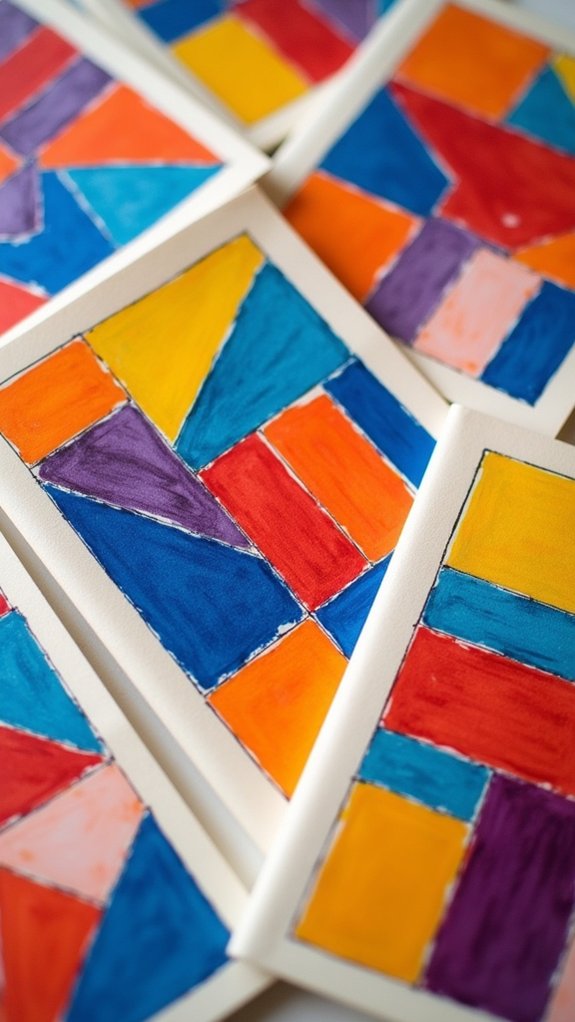
Color explosions—that’s what bold color block patterns bring to any sketchbook cover. These patterns throw together vibrant, daring colors in crisp geometric shapes—a party for the eyes!
Want a seriously sleek look? Try sticking to a few favorite colors. Limiting your palette makes those bold shades pop while still looking pulled together, not like confetti chaos.
For extra wow-factor, mix up the textures—maybe one color block is glossy and the next is matte, so your cover catches the light every time you move it. Playing with the size of each block really changes the vibe, too—giant chunks look dramatic while smaller blocks keep things playful.
For sketchbook covers ideas that last, use great supplies like acrylic paint or washi tape. That way, your masterpiece survives backpack journeys!
Mixed Media Collage Creations
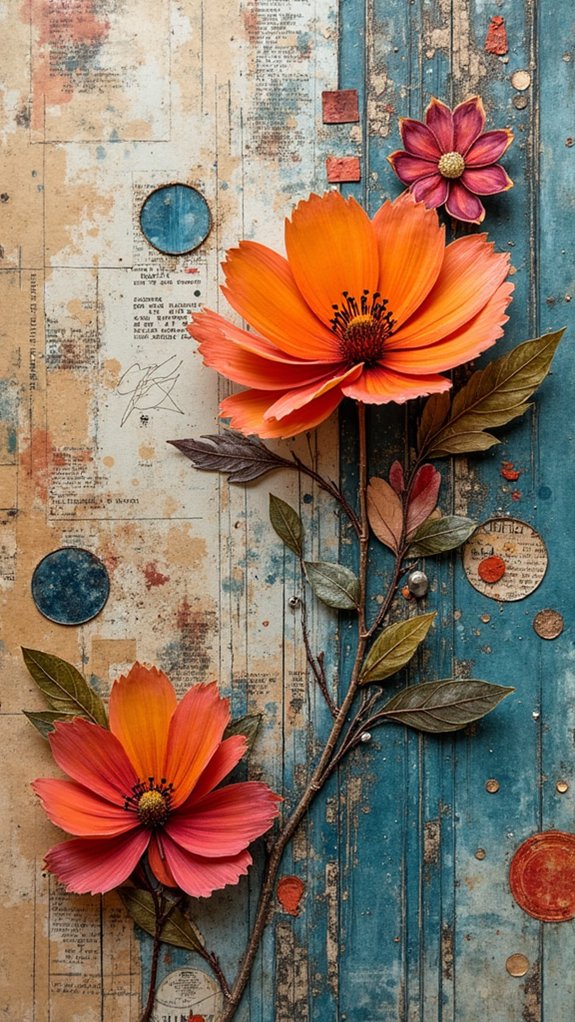
Mixed media collage creations take sketchbook covers to a whole new level by layering different textures for some seriously cool effects—think fabric scraps, ripped papers, and maybe even a candy wrapper or two.
Layering for Dynamic Texture
Immerse yourself in the world of texture and let your creativity run wild—layering different materials is like giving your sketchbook cover its own secret story.
Mixed media techniques make it super fun to experiment with sketchbook cover ideas that pop. By combining vintage paper scraps, cool fabrics, and snazzy magazine clippings, you can build up a surface that looks—and feels—totally unique.
Think of layering as stacking up stories on your cover, one exciting bit at a time.
Here’s how to make your collage sing:
- Select a variety of papers and fabrics for different textures.
- Use adhesives like Mod Podge for easy, secure sticking.
- Enhance with washi tape, stamps, or doodles for extra flair.
- Finish with a coat of varnish for polish and protection.
Incorporating Found Materials
Once experiments with layering have set the stage, it’s time to grab some funky found materials and let the scavenger hunt begin!
Imagine flipping through old newspapers, digging up vintage papers, or even finding that weird receipt from last summer’s ice cream run. Using these found materials for a mixed media collage instantly boosts visual interest and adds a “look-at-me!” vibe to any sketchbook cover.
Throw in magazine clippings or fabric scraps—you can totally mix things up to create cool textures and patterns. Some people even add postcards for a pop of memory or personality.
To make everything last, seal the finished piece with a protective layer like Mod Podge.
Galaxy Watercolor Effects
A sky full of swirling galaxies makes for one awesomely epic sketchbook cover, and creating that magical space vibe is way easier than you might think.
Galaxy watercolor effects let you blend rich blues, purples, and inky blacks to make a cosmic background that almost feels endless. Here’s an easy way to make your cover totally out of this world:
- Layer watery stripes of blue, purple, and black using watercolor for that deep-space depth.
- Flick white paint using a toothbrush to create clusters of stars—just try not to splatter yourself!
- For Mixed Media Art magic, paint bold planets or glowing moons with acrylic paint for extra contrast.
- When it’s dry, seal everything using Mod Podge or a protective spray so your galaxy lasts forever.
It’s pretty much a portal to another universe!
Minimalistic Black and White Line Art
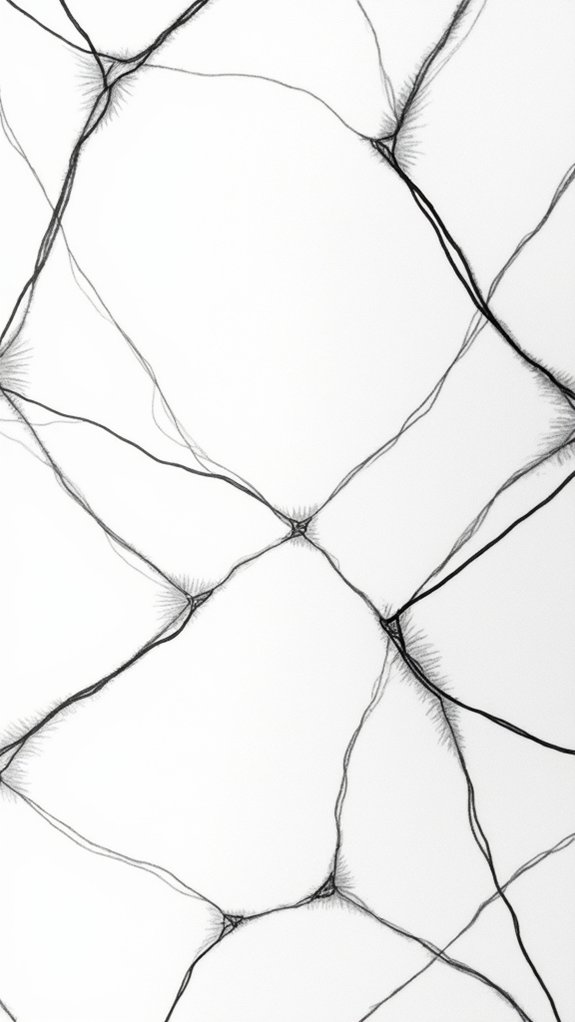
Minimalistic black and white line art packs a punch by keeping things super simple—bold lines stand out in sharp contrast against empty space, like the art version of a mic drop.
It’s pretty cool how even an ordinary mug or plant can look totally new when you leave out all the extra details and just focus on the shape and space around it.
With nothing but black ink and blank paper, it’s amazing how much style and attitude you can put on a sketchbook cover, no fancy colors needed.
Striking Contrast With Simplicity
Even with just black ink and a clean sheet of paper, a sketchbook cover can turn heads if it’s rocking some bold line art. The secret? Striking contrast with simplicity. That means using minimalistic designs—think crisp, simple shapes or flowing lines—to make your art pop without any color at all.
The cool thing is that black and white never goes out of style, so your sketchbook always looks sharp and interesting. Here’s how to nail the look:
- Use bold lines and clear shapes—keep it neat, not messy.
- Leave plenty of empty (white) space for dramatic effect.
- Try abstract doodles or outline your favorite objects.
- Use a fine-tip pen or marker for clean, precise lines.
Minimalistic art can totally steal the show!
Exploring Negative Space
Switching gears from those crisp bold lines, there’s a whole new way to make your sketchbook cover stand out—by letting empty space do some of the talking.
Minimalistic black and white line art is like the ninja of design, using sharp, simple lines to create eye-catching media while giving negative space a starring role. For anyone diving into their next art journal page, this style invites lots of creativity.
Try geometric shapes or abstract lines, and play with line thickness for extra drama. The funny thing is, sometimes the most powerful part is what you don’t draw! Leave spaces empty to make people look twice and wonder what’s missing.
Tiny fine details and bold contrasts punch up the design without overwhelming the viewer.
Everyday Objects Reimagined
A regular old mug, a pair of scissors, or even a slice of bread—these might sound boring at first, but in black and white line art, they suddenly become pretty cool. That’s the magic of minimalistic drawing.
Artists pick everyday objects and turn them into bold, elegant designs using nothing but clean lines and empty space. Who knew simplicity could look so sophisticated?
To nail this style for a sketchbook cover, remember these tips:
- Focus on clear, precise outlines to define the object.
- Leave plenty of negative space—less really is more!
- Play with thickness, making some lines bold and others super thin for contrast.
- Try geometric shapes or loose, wiggly lines depending on your mood.
Minimalistic line art proves everyday objects are never boring!
Botanical Pencil Illustrations
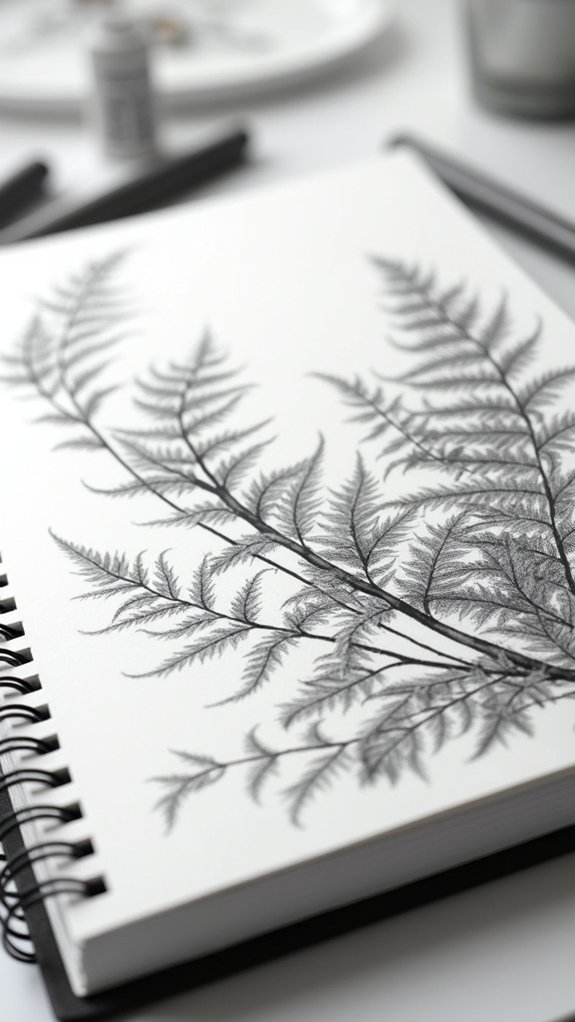
While some might think flowers and leaves are just doodles for the daydreamers, botanical pencil illustrations prove there’s real magic in the tiniest details of plants.
Imagine flipping open your sketch book and seeing a fern so detailed you swear you could smell the forest! Artists who focus on botanical pencil illustrations spend time analyzing the work—really studying each curve of a petal or twist of a stem.
They mix pencil hardness for shadows and highlights, making their sketches almost leap off the page. Negative space becomes their secret weapon, giving delicate leaves room to breathe and pop.
Sometimes they sneak in watercolor splashes for drama. Observing real plants helps sharpen those observation skills too, making each drawing more lifelike—and sometimes a bit magical.
Vintage Ephemera Assemblage
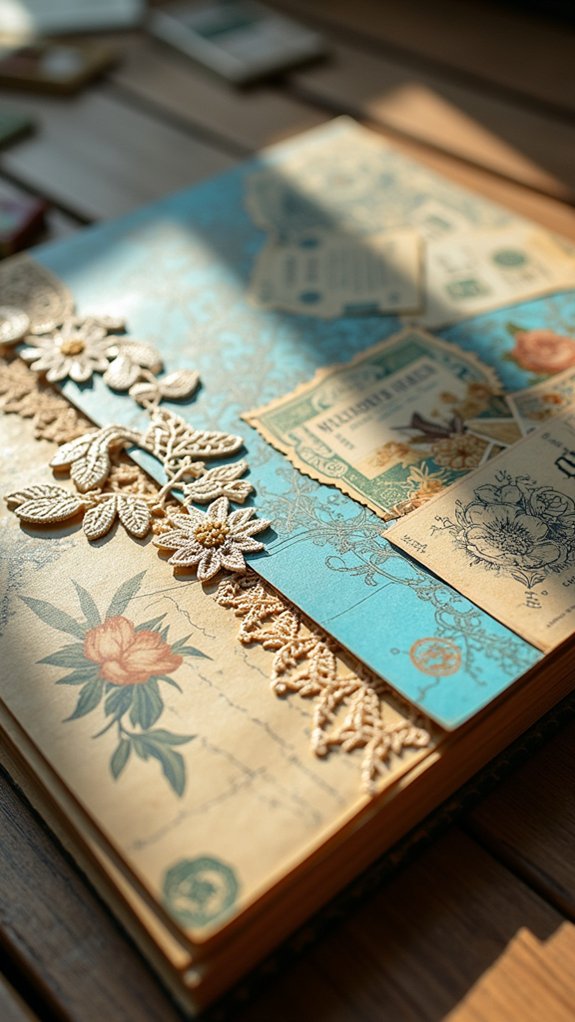
Vintage ephemera assemblage is like going on a treasure hunt—people search for old postcards, wrinkled maps, or tickets that feel full of stories, and each piece brings a cool burst of history to a sketchbook cover.
Layering these finds takes some crafty thinking; arranging paper scraps for depth and adding mixed textures can turn an ordinary cover into a piece of art with major personality.
But after all that effort, nobody wants their art peeling off, so sealing everything with Mod Podge (or another gluey shield) keeps the cover safe and snazzy for years.
Sourcing Authentic Vintage Materials
If someone squints hard enough at a dusty stack of postcards or a wrinkled old map, it’s like revealing a portal straight into another time—pretty cool, right?
That’s the magic of using vintage ephemera in art journaling and sketchbook covers.
But where do these treasures come from, anyway? Many artists know you don’t have to be Indiana Jones to track down authentic stuff.
Here are four trusty ways to start your own collection:
- Hit up local thrift stores or flea markets for forgotten letters and faded photos.
- Browse antique shops for maps, tickets, and paper odds and ends with character.
- Explore online on Etsy or eBay for hard-to-find pieces and themed bundles.
- Check out local libraries for public realm archives to digitize and print.
Layering Techniques for Depth
Stacking layers of old book pages, postcards, and faded photographs is kind of like building a time machine—each piece adds its own secret story, and the results can look seriously cool.
When using layering techniques with vintage ephemera, it’s all about mixing and matching textures and colors for a cover that pops. Imagine sliding a patch of textured paper behind a sepia-toned photo, then tucking a handwritten postcard on top—suddenly the design looks deep and exciting.
Play around with placement and scale; try letting an old ticket stub peek out or overlapping corners at funky angles. Stick with a palette of muted tones to keep it vintage-y.
Pastes like Mod Podge help everything stick while adding a shiny or matte finish, your choice!
Sealing and Preserving Ephemera
Locking in a one-of-a-kind collage takes more than just some careful gluing—preserving all those treasured bits of ephemera calls for a trusty sealant.
Think of it like giving your sketchbook cover a shield—no more worrying about your vintage paper turning yellow or getting scratched up. That old train ticket or postcard from Grandma? Still safe and snug years later!
Here’s how artists can seal and preserve their ephemera masterpieces:
- Pick an acid-free sealant (like Mod Podge) to keep colors bright and prevent any yellowing.
- Mix textures and weights, but beware—the chunkier the layers, the harder it’ll be to close your sketchbook!
- After gluing, add one more coat of sealant for protection and a cool finish.
- Try see-through elements like vellum for secret-peek vibes!
Character Illustration With Vibrant Colors

When it comes to sketchbook covers, nothing grabs attention quite like a character illustration bursting with vibrant colors. These illustrations are eye-magnets, thanks to bold hues, striking contrasts, and clever color combos that make characters leap right off the page.
Artists often use tools like alcohol markers for juicy, saturated tones, or colored pencils for smooth blending and detail. Mixing in collage or even a bit of digital magic—yep, that’s mixed media—adds awesome texture and depth, making characters look extra cool and three-dimensional.
Of course, knowing your character design basics, like getting the anatomy right, keeps them from looking like bendy noodles. For wild inspiration, cruising through Instagram or Pinterest can spark fresh ideas for both character styles and exciting color schemes.
Typography and Hand-Lettered Quotes
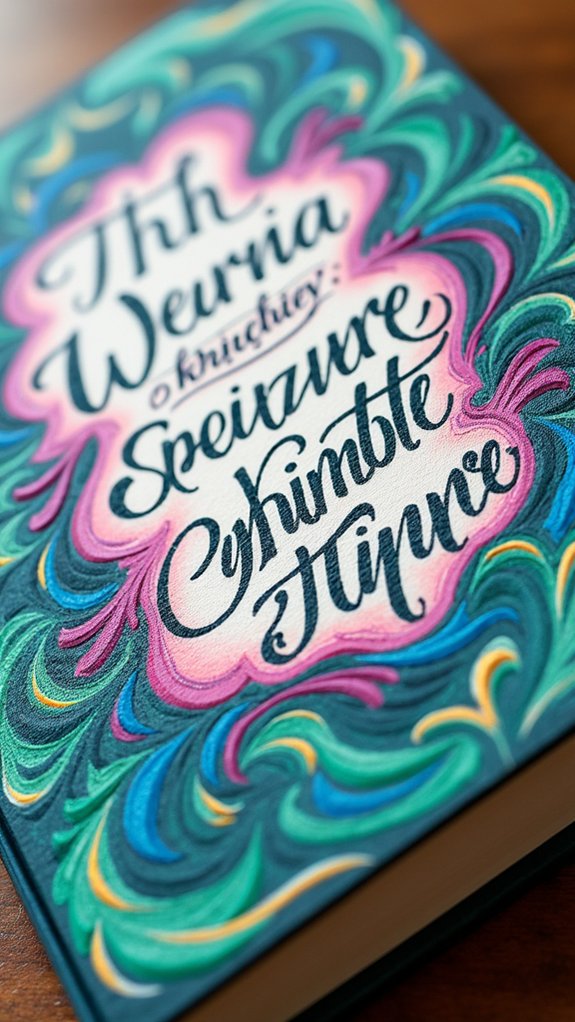
Bold words and splashy quotes can turn a plain sketchbook cover into something totally unforgettable.
When looking for fresh sketchbook ideas, typography and hand-lettered quotes are total game changers. They not only add visual punch, but also show off the creator’s personality and vibe.
There are so many ways to play around and make your cover pop. Consider these tips:
- Try out different lettering styles—think brush lettering, calligraphy, or block letters.
- Choose a quote that really captures your mood, or invent your own for a super personal touch.
- Add shadows, outlines, or even little doodles around your words to boost the wow factor.
- Mix typography with small illustrations for a creative combo that really stands out.
Let your words shout from the cover!
Abstract Acrylic Texture Layers
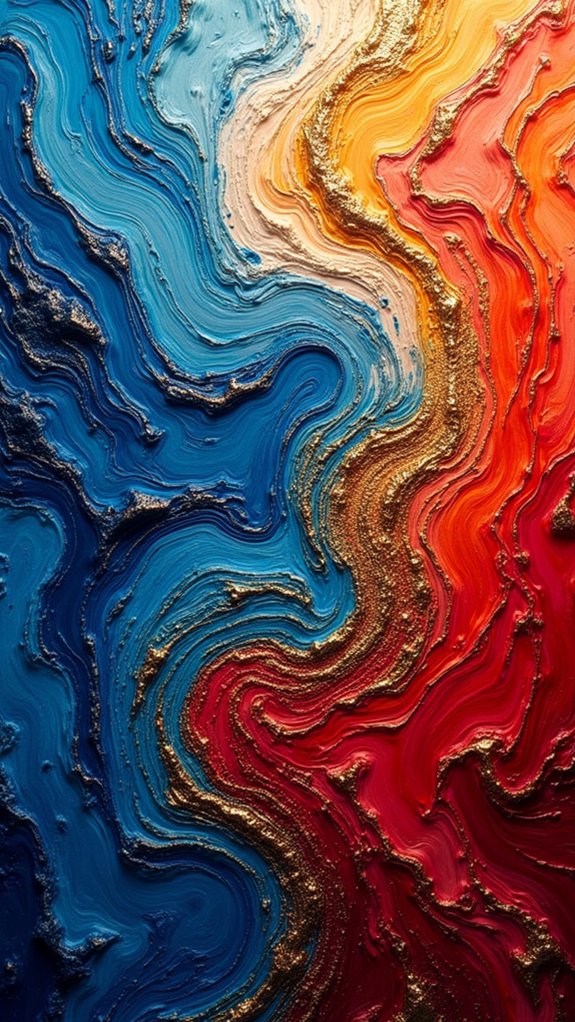
Abstract acrylic texture layers are a blast for building rich color depth, especially when artists start piling on paint with palette knives like they’re frosting a cake—only much messier and way more fun.
Smearing thick swirls and scraping across wet paint can create incredible patterns that almost look good enough to touch (but maybe ask before poking someone’s masterpiece).
With each new layer, colors peek through from underneath, letting the artwork show off wild surprises and little secrets just waiting for someone to notice.
Building Rich Color Depth
Dive right in—adding rich color depth with abstract acrylic layers isn’t just painting, it’s like building a wild, colorful lasagna for your eyes.
Each squiggle and swipe of acrylic paint stacks on top of the last, making the cover art look exciting and alive. Want your sketchbook to jump out at everyone? It’s all about clever layering, awesome texture, and a few handy glazing techniques.
- Start with a solid base layer of acrylic paint, which sets the stage for all the drama to come.
- Add bold texture layers using sponges or palette knives for thick, fun swaths of color.
- Glazing techniques add transparent, glowing finishes—just mix glazing medium into your paint.
- Toss in extras like sand or paper for crazy dimension, letting each layer dry first!
Experimenting With Palette Knives
Sometimes, all it takes is one palette knife to totally shake up a boring sketchbook cover and turn it into an explosion of texture.
Palette knives are like magic wands for acrylic paints—they scrape, smear, and pile colors in ways you just can’t get with a boring old brush.
Try using different palette knives: thin ones make sharp lines, and chunky ones layer thick, gooey globs of paint for wild, 3D effects.
Mixing acrylic paints with texture gels or pastes can give every swipe extra oomph, sending textures leaping off the page.
Start with a flat color, let it dry, then go wild layering more shades on top, blending or contrasting them as you go.
Surprise yourself—the messier, the cooler.
Seasonal and Holiday Motifs
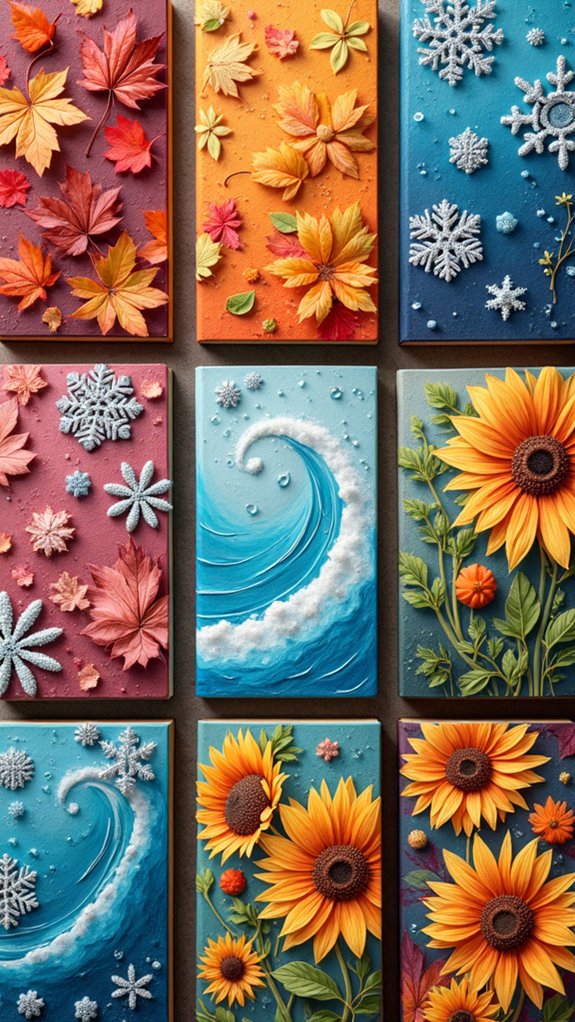
When autumn leaves start hitting the ground or the first snowflakes of winter dance in the air, it’s almost impossible not to feel inspired by the changing seasons.
Sketchbook artists can use seasonal motifs and holiday motifs to totally boost the energy and mood of their covers. There’s nothing like a bright pumpkin, a cozy cluster of pressed leaves, or a shimmering snowflake to transport viewers right into the spirit of the season.
Plus, using mixed media really ramps things up! Try these ideas for eye-catching sketchbook covers:
- Layer autumn leaves and acorns with watercolor backgrounds for a dreamy fall vibe.
- Use fabric and glitter to create sparkling Christmas tree or snowflake designs.
- Glue on real pressed flowers in springtime palettes.
- Experiment with cool, icy blues or warm, pumpkin-inspired oranges for color impact.
Illustrated Self-Portraits
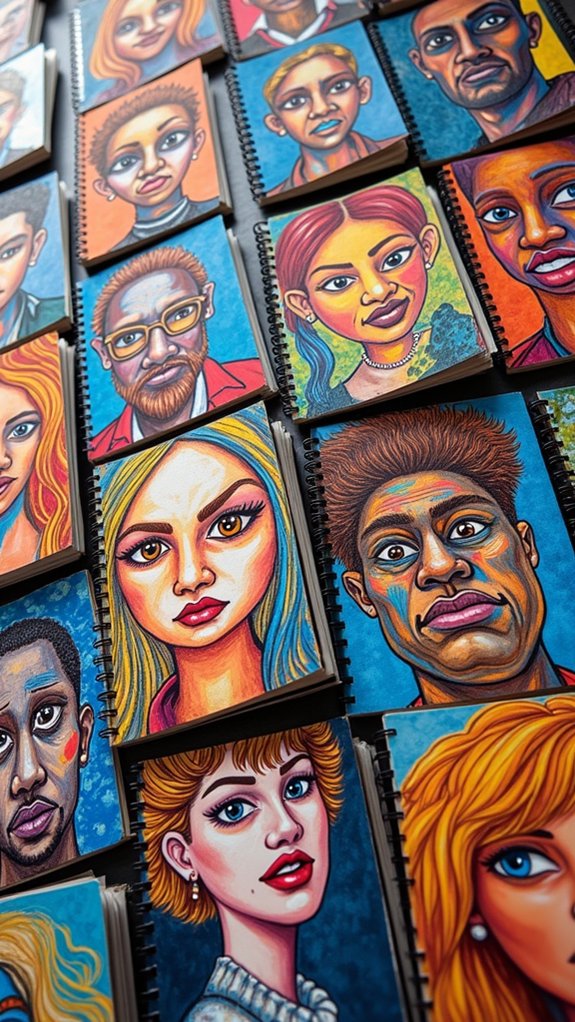
Self-portraits might sound intimidating, but they’re actually one of the coolest ways to make a sketchbook cover scream “this is me!” There’s no rule that says a face has to be just eyes, a nose, and a mouth drawn in pencil—artists like Giuseppe Arcimboldo made faces out of things like fruit and veggies, proving that identity can be as wild or as wacky as you want. Illustrated self-portraits let students explore personal themes while playing with mixed media techniques, blending collage, markers, or even magazine clippings. Want glitter eyebrows? Go for it. Prefer a background of your favorite foods? Why not! Analyzing facial features adds some structure, making the process less random and more meaningful.
| Portrait Style | Media Used | Personal Touch |
|---|---|---|
| Abstract | Collage & Pencil | Favorite colors |
| Realistic | Ink & Markers | Unique expressions |
| Whimsical | Mixed Paper & Glitter | Beloved objects |
Geometric Shapes and Repeated Patterns
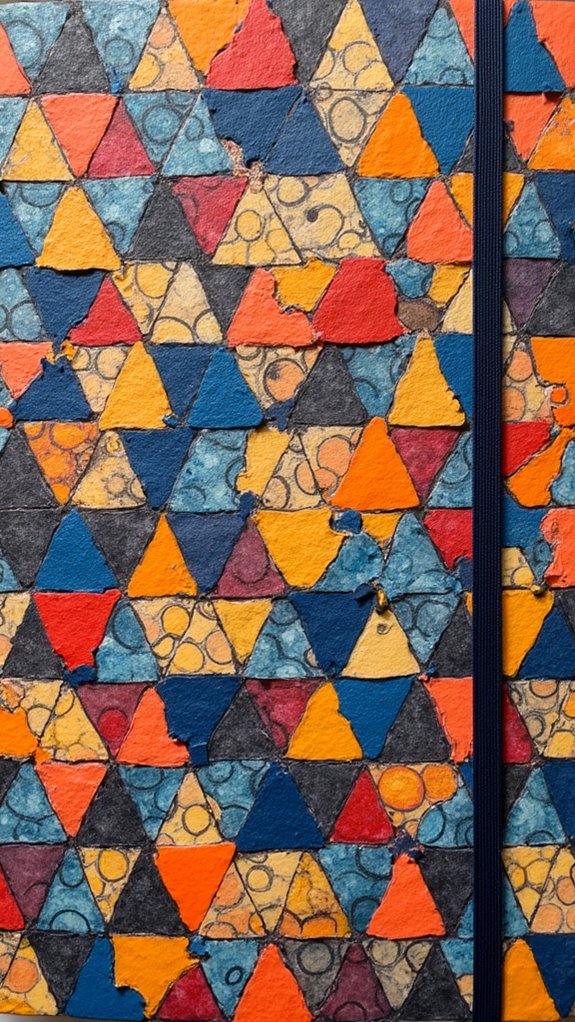
Geometric shapes and repeated patterns can totally transform a sketchbook cover, especially when you play around with cool tricks like pattern repetition for that eye-catching rhythm.
Minimalist geometric color blocking keeps things bold and clean, while overlapping different shapes adds crazy depth—almost like the cover has its own secret levels!
Mix these ideas together, and suddenly, your sketchbook is more than just a place for art—it’s a piece of art all by itself.
Pattern Repetition for Rhythm
Even though a blank sketchbook cover can be a little boring, repeating shapes and patterns instantly jazz it up with a burst of rhythm and energy.
When artists use pattern repetition with geometric shapes—like triangles, circles, or squares—they create a sense of harmony that’s super eye-catching. Suddenly your sketchbook isn’t just something to draw in—it’s showing off your style from the outside in!
Want to boost your cover’s visual impact? Try these ideas:
- Play with the size of your patterns, mixing big and small shapes for more interest.
- Combine contrasting colors inside those geometric shapes for extra pop.
- Use fun methods like stamping, stenciling, or freehand drawing—precision not required!
- Allow your repeated patterns to travel across the cover, pulling the viewer’s gaze along for the ride.
Minimalist Geometric Color Blocking
Patterns aren’t the only way to make your sketchbook cover turn heads—sometimes, less is seriously more! Minimalist geometric color blocking is all about using bold, flat colors and the simplest shapes—think triangles, circles, or squares—to make a cover scream modern art.
Visual impact isn’t just about wild designs; a limited color palette, maybe two or three really contrasting colors, can pop just as hard. Repeating shapes in a balanced way brings symmetry that just feels satisfying, like lining up the perfect row of dominos.
It’s super important to let some negative space breathe, so those crisp geometric forms have room to shine. Painter’s tape is a lifesaver here, making sure those straight edges stay sharp—and your design stays seriously sleek.
Overlapping Shapes for Depth
Some covers just know how to grab attention—especially when shapes start stacking, tumbling, and sliding over each other like they’re in a mad dash for first place.
Overlapping shapes work like a magic trick, making any sketchbook look lively and full of energy. It’s not just about throwing triangles, circles, and squares into a pile; it’s about using them to create depth and motion so viewers can’t help but stare.
To pack your cover with personality, try these four ideas:
- Layer basic shapes and let them overlap for an instant boost of dimension.
- Pick contrasting colors so some shapes jump out while others settle back.
- Mix in transparency to let colors blend and surprise you.
- Repeat patterns for rhythm and extra wow-factor.
Urban Sketches and Cityscapes
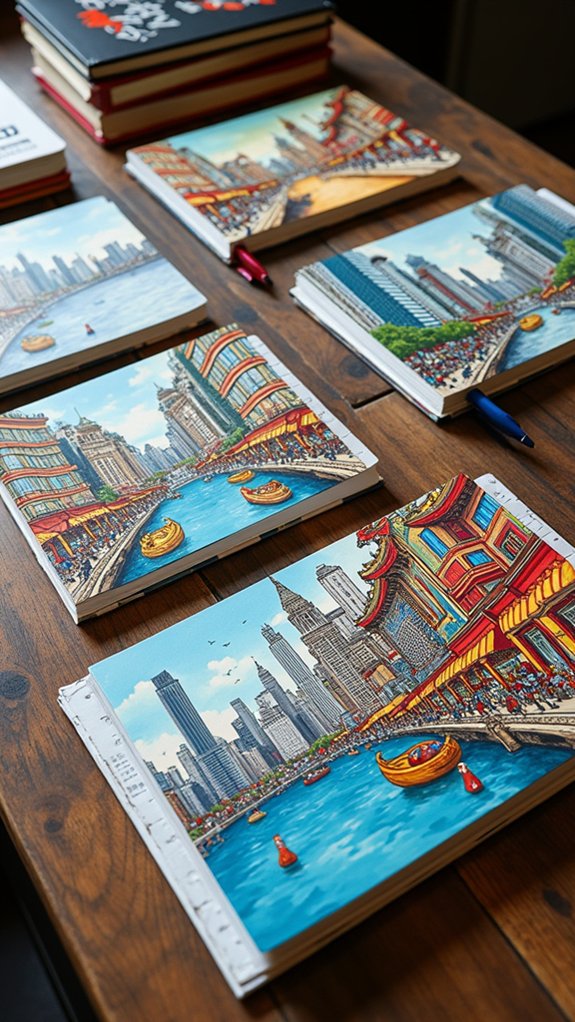
If you’ve ever walked through a city and thought, “Wow, this place has so much going on,” then urban sketches and cityscapes might just be your jam.
These sketchbook covers grab attention by showing city vibes—think tall buildings, crowded sidewalks, and cool architecture. Urban sketches are all about snapping up energy fast, using quick lines and dramatic angles.
Artists can mix watercolor with inky outlines to make cityscapes pop, adding splashes of color for traffic lights or rainy streets. Don’t forget the people: sketching folks on buses, zipping by on scooters, or chatting at a café adds movement and story.
Mixing markers, colored pencils, and even little doodles of signs or taxis brings your whole city scene to life—no skyscraper required.
Nature-Inspired Cover Art

Sunlight filtering through tree branches, the gentle swirl of wildflowers, or even a curious squirrel peeking out from behind a leaf—nature-inspired cover art turns ordinary sketchbooks into mini escapes.
Bringing the outdoors onto a sketchbook cover is more than just leafy doodles; it’s about capturing the energy and peace of nature.
Want to make your sketchbook look like it belongs in a secret garden? Try these four ideas:
- Use botanical illustrations to highlight detailed shapes of leaves and flowers.
- Experiment with watercolor sceneries or floral patterns for soft, blended vibes.
- Create a collage using pressed flowers, leaves, or earthy textured paper.
- Add wildlife imagery, like birds or gentle animals, and tie the look together with earthy color palettes.
Nature’s magic, right on the cover!
Pop Art and Comic Book Styles
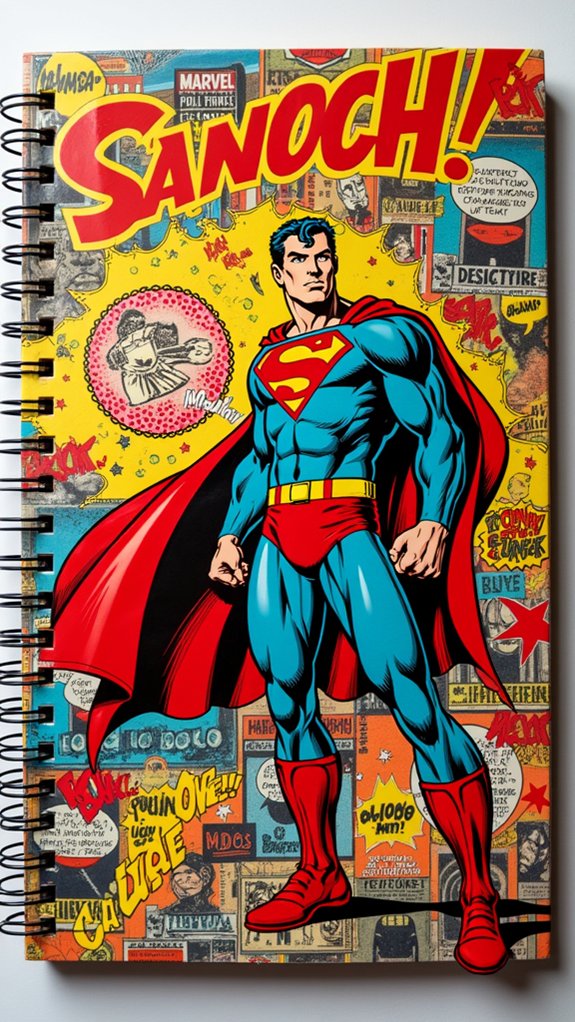
Ever wondered what happens when bright colors and comic book drama collide on a sketchbook cover? It’s pure electric excitement!
Pop art grabs your attention with bold colors, sharp lines, and wild patterns that practically shout from the page. Imagine channeling Roy Lichtenstein or Andy Warhol, using those famous comic book styles with speech bubbles, halftone dots, and exaggerated expressions—your sketchbook instantly becomes a visual explosion.
Toss in some mixed media magic, like cutting out magazine clippings and adding dabs of paint or ink, and suddenly your cover tells its own awesome story. It’s not just a cover, it’s an adventure: every glance is like flipping through an action-packed comic.
Who knew everyday art supplies could deliver such superhero-level impact?
Textile and Fabric Embellishments
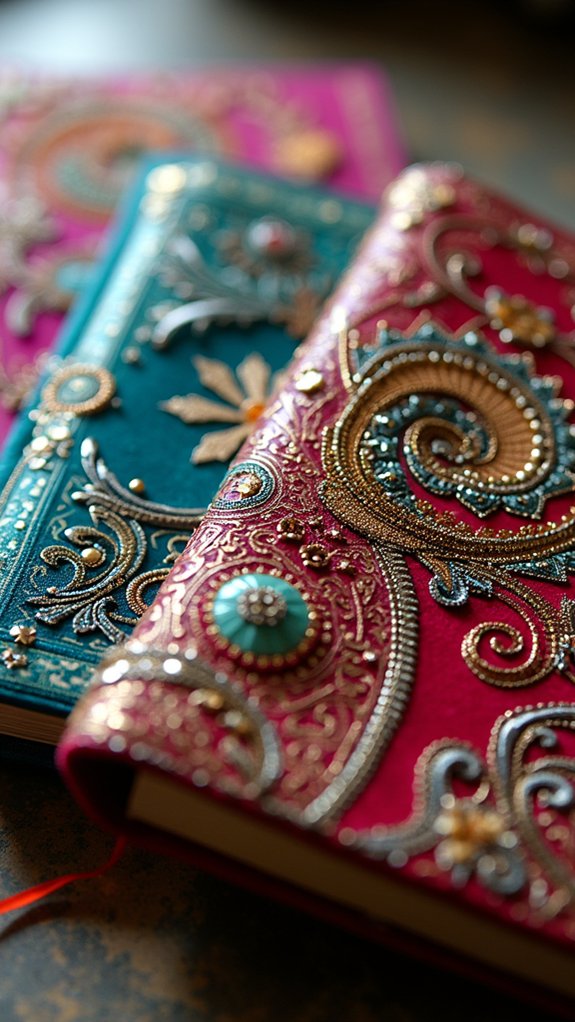
When fabric and sketchbooks collide, something totally magical happens—suddenly, it’s not just about what you draw inside, but how the cover feels under your fingers.
Textile and fabric embellishments transform plain covers into something you can’t help but touch (and maybe even show off). There are endless ways to play with different materials, mixing textures and patterns for maximum wow-factor.
Here are a few fabric ideas to try:
- Use felt, cotton, or burlap to create soft or rustic vibes.
- Sew or glue fabric shapes for cool patterns or unexpected pops of color.
- Decorate the fabric embellishments with paint or markers to make each piece unique.
- Add lace, ribbon, or layered textiles to build texture and visual excitement.
Fabric covers—seriously, who could resist?
Monochrome Ink Wash Designs
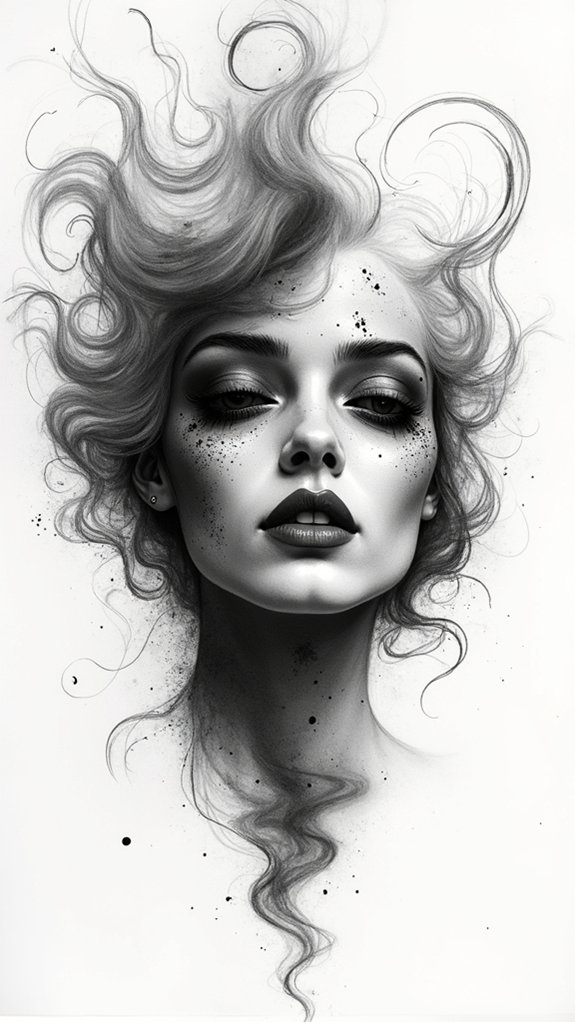
Ink has a way of making everything look cooler, and a monochrome ink wash cover takes things to a whole new level. By using just one color—usually black or gray—artists can create a sketchbook cover that looks mysterious and bold at the same time.
This style lets you experiment with how light or dark you want things, just by adding more water or less ink. You can build up layers for rich shadows or wash it all out for a foggy, dreamlike effect.
Want more details? Just grab a fine brush or ink pen and add lines or tiny dots on top. Mixing in some collage or other mixed media tricks can make your cover truly one-of-a-kind, standing out from the crowd instantly.
Doodle Art and Zentangle Covers
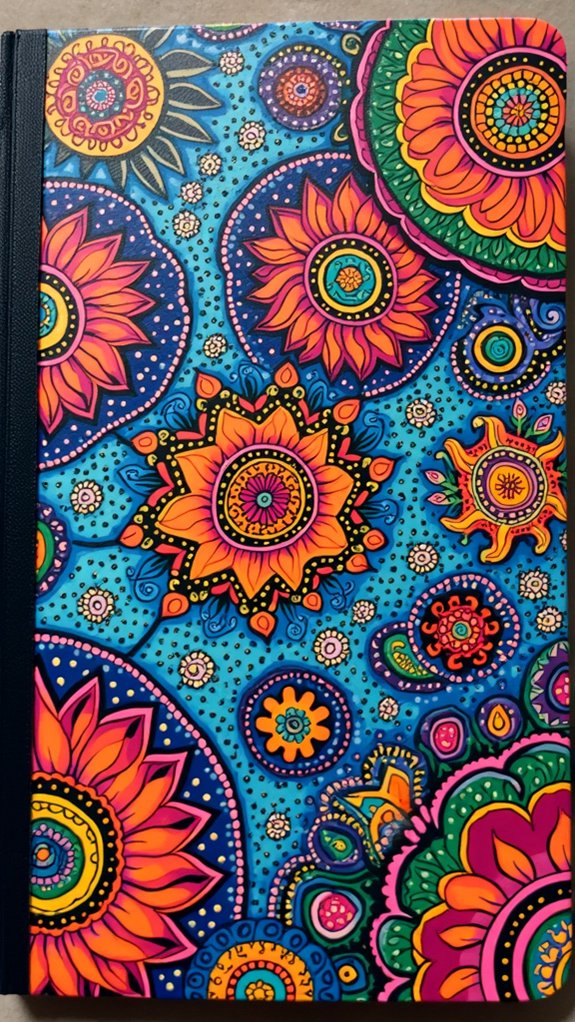
After exploring moody ink wash effects, things can get way more playful—and maybe even a little wild—with doodle art and Zentangle covers.
Kids and adults alike can fill every inch of their sketchbook cover with wild swirls, random shapes, or even entire worlds made from squiggles. Doodle art encourages maximum creativity, while Zentangle techniques add a sense of calm, like meditating with a pen.
For artists looking to make their covers pop, here’s what works best:
- Use fine-tip pens to draw tiny patterns or elaborate doodles.
- Mix in varied line thicknesses to build eye-catching depth.
- Play with high-contrast colors for serious visual impact.
- Try mixed media—blend doodle art with watercolors or collage for next-level style.
Suddenly, doodling isn’t just for daydreaming!
Personal Symbols and Thematic Imagery
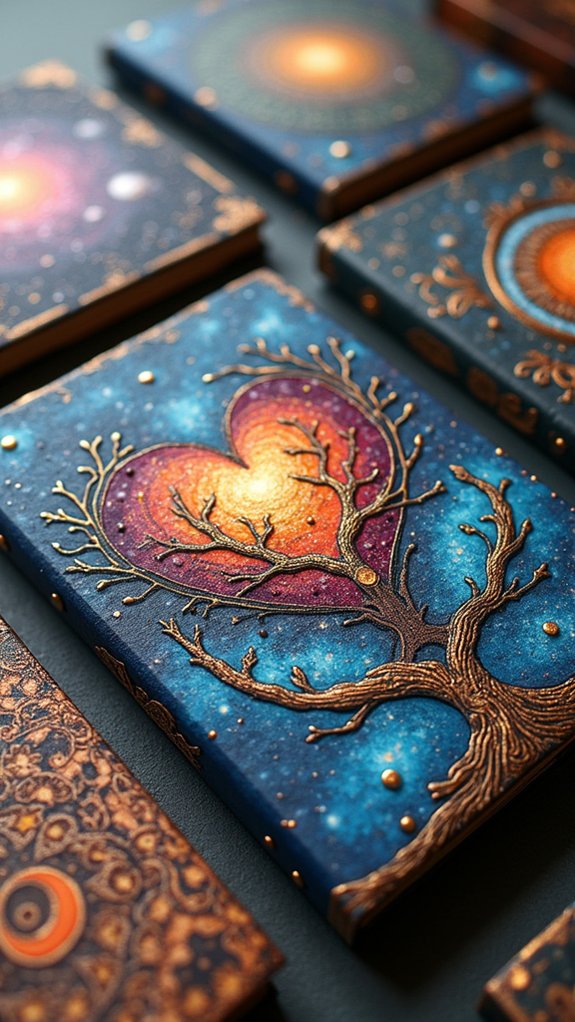
Dive headfirst into the world of personal symbols and thematic imagery, and watch a sketchbook cover transform from blank and boring to something that shouts “this is me!”
Every artist carries a bundle of ideas, memories, and favorite things—so why not slap those right on the front? Think about it: a favorite color splashed across the surface, a secret quote doodled in the corner, or a wild, swooping design that shows off what you love.
Thematic imagery—like mysterious forests, mythological creatures, or just a hint of your pet’s goofy face—creates a visual story unique to you.
Try mixed media: mash collage, acrylic paint blobs, or even magazine clippings together. Suddenly, the sketchbook isn’t just paper—it’s your personal, artsy billboard.
Frequently Asked Questions
How Do I Make My GCSE Art Sketchbook Look Good?
To make a GCSE art sketchbook look appealing, one should select cohesive sketchbook themes, utilize harmonious color schemes, and add personal touches. This approach showcases individuality, enhances visual flow, and demonstrates thoughtful organization throughout the creative process.
What Should I Put on the Front of My Sketchbook?
When considering what to put on the front of a sketchbook, one might explore sketchbook themes, incorporate artistic styles, and highlight personal expression through meaningful imagery, favorite colors, memorable quotes, or motifs that genuinely reflect the artist’s individuality.
How to Make Your Sketchbook Interactive?
To make a sketchbook interactive, one could add interactive elements like flaps or pockets, include creative prompts on pages, and utilize augmented reality by integrating QR codes that link to multimedia or digital content for enhanced engagement.
What to Include in a Level Art Sketchbook?
An A Level art sketchbook should feature key art techniques, annotated visual inspiration sources, and effective layout design. It must display technical skill, experimentation, process documentation, artist analysis, and reflect on personal growth through both studies and resolved works.
Conclusion
Picking the right art for your sketchbook cover is kind of like picking your superhero costume—bold, unique, and totally you. Whether you go for wild color blocks, mysterious galaxies, or just wild doodles, your cover tells the world who you are before they even see your art inside. So go ahead and experiment—swap out styles, get a little messy, and most of all, have fun making your sketchbook stand out from the crowd!

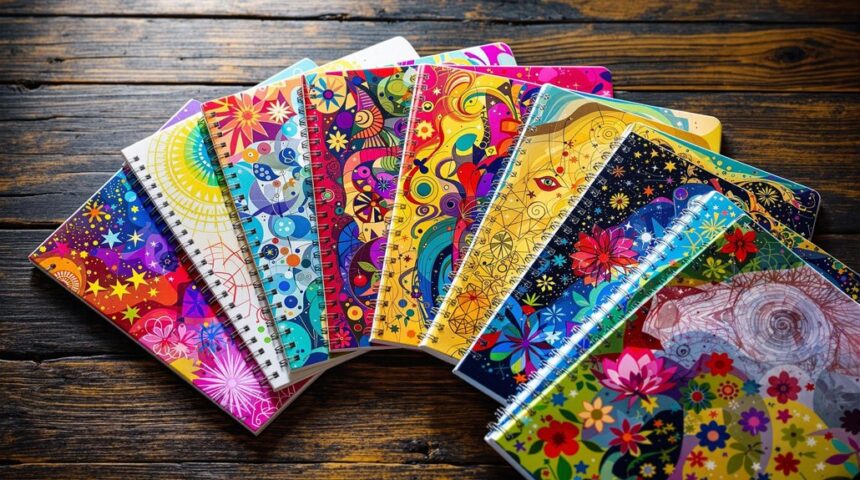
Leave a Reply